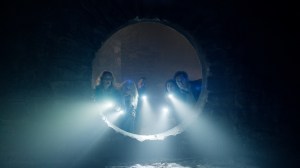Finding ways to breathe life into a well-worn genre like infection horror can be a daunting task, especially when The Walking Dead and its shambling corpses have dominated both the world of comic books and television for the better part of a decade. With Spread, created by Justin Jordan and Kyle Strahm, horror fans were delivered a series that wore its influences on its sleeve while never aiming to reinvent the wheel. The series’ final issue delivered on both fronts, offering audiences buckets of blood and grotesque sci-fi atrocities despite not pushing the story into unexpected territory.
Videos by ComicBook.com
The first issue of Spread introduced readers to a familiar horror premise: an infection has begun, well, infecting humanity, turning its victims into unrecognizable beasts. Rather than something recognizable or easily defined, the infected would merely become part of “The Spread,” which are mutated beasts that appear part animal, part human, and all horrific. The only hope for humanity rests in the saliva of a baby, nicknamed “Hope,” who came into the guardianship of a gruff badass, nicknamed for the word he most often said, “No.”

The series’ biggest villain, Ravello, has gone from the Negan-esque tyrant of a community of scavengers to the embodiment of the Spread itself, aiming to destroy Hope and crush the possibility of ending the beings once and for all. With his unlikely brother-in-arms Jack and recently reunited sister, No, who we’ve learned is actually named Sean, makes his stand against Ravello as the creatures unleash their absolute worst against humanity’s last chance at survival.
It came as no surprise that Hope survives the entire ordeal, as she introduces herself in the first issue as the series’ narrator. No matter what our heroes faced throughout the series, the stakes always felt somewhat low, as we knew that the character would survive. That isn’t to say it’s been without its surprises, from revealing No’s actual name and offering readers a modicum of his humanity to unexpected deaths, but you always had the feeling the human race would prevail.
One reason that horror fans never grow tired of seeing stories that pit humanity against their potential demise is that they offer the escapism of living in a world where you don’t have to think about social media or working a 9-to-5 job anymore, while often offering up critique about what would happen to our society were we faced with the apocalypse. Spread delivered on that escapism, yet never offered much in the way of a deeper narrative. Were this the intention of the creators, to merely offer audiences a fun and bloody story, then they absolutely made good on that promise, while some readers might wish that they had been given something meatier to chew on.

Since the first issue, the biggest strength of Spread has been its horrifying monsters, which are clearly inspired by the works of John Carpenter’s The Thing. The bright red beasts always popped against the relatively muted colors of the decaying world, regularly leaving readers with creatures so hideous you could almost touch the page and feel their mucus-covered flesh. Strahm and John Bivens worked together on this issue’s art, utilizing both of their abilities to their full potential for another visual feast.
Looking back on the series, which ultimately felt like a Logan-esque narrative told through the eyes of filmmakers George Romero and David Cronenberg, it ultimately delivered a satisfying story about about the end of the world that broke free from the overwhelming number of zombie comics out there, whose weaknesses and strengths have been ingrained in everyone’s minds. Spread offered a new take on the end of humanity, and, while the series’ arc about a sanctuary community had little to do with the story’s overall trajectory, delivered some of the most disturbing creatures you could conjure in an ongoing comic book.
The final issue gives audiences a handful of somewhat surprising moments that satisfy by doubling down on what we’ve grown to love about the book: gnarly-as-hell monsters tearing people’s bodies apart.
Published by Image Comics
On March 7, 2018
Written by Justin Jordan
Art by John Bivens & Kyle Strahm
Colors by Felipe Sobreiro








